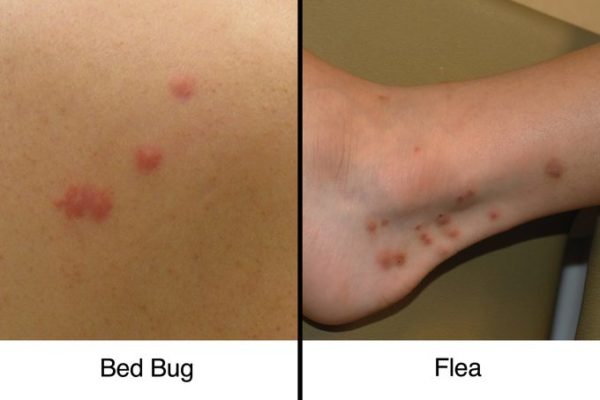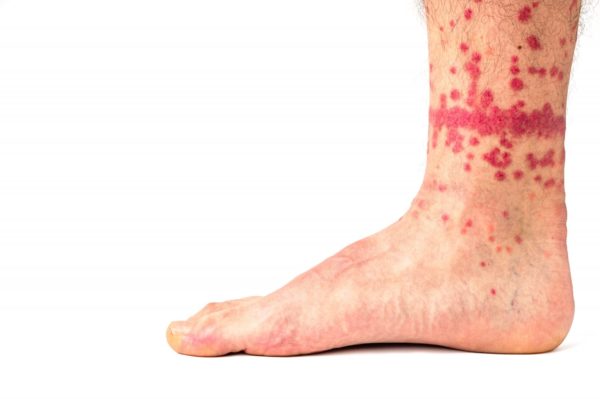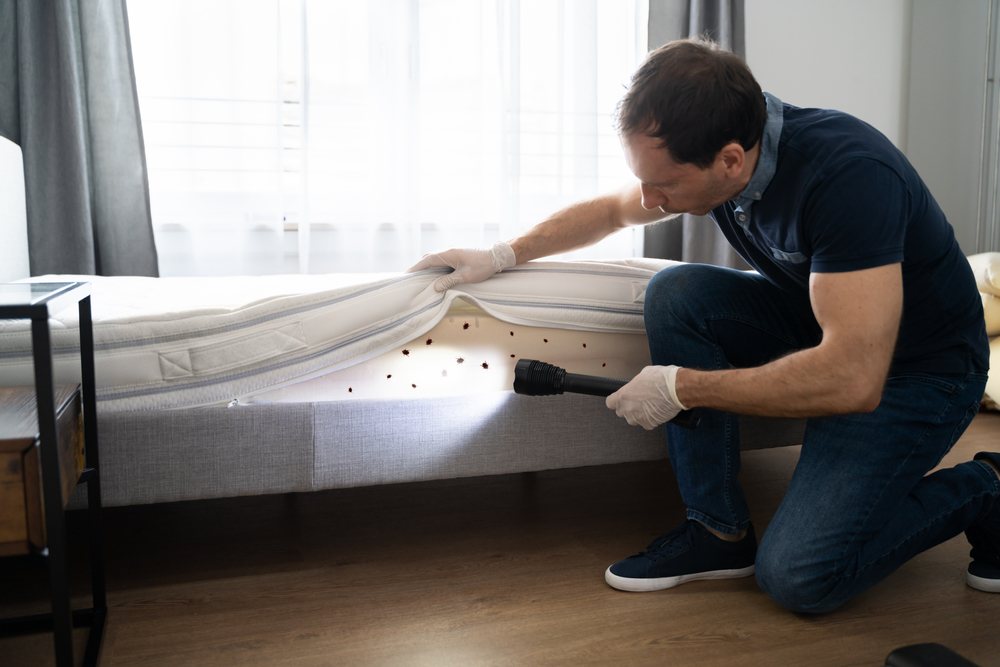When you notice little red bumps on your skin, it’s natural to wonder where they came from.
While some insect bites are more obvious than others…
(think mosquitos or ticks).
Most of the time bite marks look very similar between different insects.
Here we are going to talk about 3 ways to tell the difference between bed bugs and fleas.
To begin, we will need to establish what bed bug bites look like.
Bed bug bites are known to appear as clusters of reddish-brown welts around the area of the bite.

On average, bed bugs bites start to itch within 2 – 3 hours after being bitten.
Both of those traits are similar with flea bites.
Page Contents:
Here Are The 3 Main Differences Between Bed Bug & Flea Bites
- Location of the Bites
Knowing where the bulk of bite marks are on your body is a good indicator of what’s biting you. Bed bugs will usually target the upper torso, while fleas target the lower extremities like the legs.
Why?
Because bed bugs, as the name suggests, often make their nests in or around bedding material like sheets and mattresses.
Since they often nest toward the head of the bed, bed bugs will gravitate toward the upper torso and the arms when they feed.
(Though a bed bug mattress protector could fix that).
Fleas, meanwhile, tend to target the legs.
This is because…
Your legs are typically within leaping distance for fleas. They can’t fly, so fleas find hosts to feed off of by jumping.
Unlike bed bugs, fleas can jump an average height of 13 inches.
Secondly, fleas rarely target humans but will feed on them if they need a new food source.

As most pet owners can attest, fleas are more at home on dogs or cats.
This is because animals are lower to the ground than us and are easier to access.
We sometimes get bitten because migratory fleas will wind up jumping from the backs of our furry friends and onto our lower limbs.
- Size & Color
Size and color are important factors in determining any kind of insect bite. And while the differences may seem minor at first glance, there are several clues to help distinguish a flea bite from a bed bug bite.
Flea bites are smaller and usually appear bright red in color. These bites are so closely grouped together that they might even form patterns across your skin.

Bed bug bites are slightly larger, and while they still look like reddish welts, they’re not as bright red as flea bites.
Bed bug bites don’t make up any complex patterns. Instead, they’re grouped together in a line or zigzag.
- The Time of Day That You Were Bitten
The feeding habits of these bugs can make a world of difference in identifying what bit you.
As mentioned earlier, bed bugs are nocturnal creatures. During the day, they gather together in secluded hiding places.
Since bed bugs rarely venture out during the day, chances are they won’t seek out a meal.
In contrast, fleas don’t follow a set schedule: they feed whenever they want to feed, and they travel whenever they want to travel.
You’ll know right away if you’re dealing with fleas because you’ll see them crawling along your body during the day.
(A bed bug is not likely to do that).
Are There Any Similarities?
Aside from the coloration, there are a few shared traits between flea bites and bed bug bites. These often relate to the symptoms that accompany each bite.
Both types of bites will start to itch not long after you’ve been bitten.
But why don’t you feel yourself being bitten in the moment?
During a feeding session, bed bugs and fleas inject saliva into the bloodstream. Their saliva contains anticoagulants to keep the blood from clotting, and antihistamines to prevent any immediate itching.

This allows them to drink human blood without incident. Once the antihistamines wear off, that’s when the itching sensation begins as your body tries to fight off the other bacteria carried in the saliva.
Unfortunately, bites from both creatures can be potentially dangerous.
This is because both bed bug bites and flea bites have a chance of severe infection.
This usually occurs from excessive scratching that creates an open wound on the skin. While scratching bite marks might temporarily relieve the itching, it also keeps the wounds open and spreads lingering bacteria.
Another thing that’s harmful is if you have insect-related allergies and severe reactions to insect bites. If you ever develop an allergic reaction you should seek medical attention immediately.
How To Treat Flea Bites
Flea bites will typically heal on their own within a week.
To speed up the process or alleviate symptoms, here is what you can try:
- Over-the-Counter Treatments: After a flea bites you, your body begins producing a protein called histamine to fight off foreign bacteria. Histamine is what causes bug bites to itch, so taking over-the-counter antihistamines can help you resist the urge to scratch bite marks.
Antihistamines come in 2 forms:
- Oral antihistamine pills
- Topical antihistamine creams that can be applied directly to the bites.
Lotions: Skin lotions, like aloe vera gel and calamine lotion, can also relieve itchiness. Their cooling properties reduce swelling and inflammation, while the minerals and vitamins found in them moisturize the skin and promote healing.
Home Remedies: There are plenty of home remedies you can use to treat flea bites. Cold compresses and liquid astringents, such as witch hazel or apple cider vinegar, are 2 commonly used home treatments.
How To Treat Bed Bug Bites
Like flea bites, bed bug bites will naturally heal after 1-2 weeks. The treatment methods for bed bug bites are also the same as the aforementioned treatments for flea bites.
Whether you’re using antibiotic treatments or simple home remedies, routine treatment is an important part of the healing process.
Not only do the above treatments help your body’s immune system, they also reduce the severity of the symptoms associated with bug bites.
Reducing the effects of the symptoms means you’re less likely to experience skin irritation, which reduces the risk of infection or other harmful symptoms.
Common Symptoms of Insect Bites
Fleas and bed bugs aren’t the only biting insects out there. Ticks and mosquitos also view humans as a source of food and bite us to drink our blood.
Spiders, meanwhile, will only bite humans in self-defense: even then, a spider’s fangs are too small to penetrate human skin.
Most spiders also lack venom strong enough to do any serious harm to humans: the most notable exceptions are black widows and brown recluses, who both have more potent venom and can be hard to get rid of.
After an insect bites you, you’ll notice swelling and redness around the area of the bite.

In some cases, you’ll see an open wound where the skin was broken. Spiders bites, for instance, will consist of 2 small puncture wounds in your skin.
Some bug bites will take on a distinct pattern. As mentioned earlier, flea bites and bed bug bites may appear in clusters or in zig-zag patterns. Ticks will leave behind a “bullseye” shape, with a large ring surrounding the actual bite.
skin irritation is another common symptom, as your immune system begins the process of eradicating the foreign bacteria injected by insects.
In addition to fleas and bed bugs, mosquitos also inject antihistamines and anticoagulants into the bloodstream to stave off itching and clotting while they drink.
If left untreated, bug bites will heal on their own. However, repeated itching or aggravation of the wounds can lead to serious infections; this is why scratching bug bites isn’t recommended by health experts.
Summary
Both bed bugs and fleas can become a huge problem if not dealt with quickly.
The key similarities and differences between fleas and bed bugs are highlighted in the below table.
Bed Bug Bites vs. Flea Bites
| Differences | Similarities |
|---|---|
| Bite Location | Bite Symptoms |
| Size & Color | Can Cause Infection |
| “When” These Insects Bite | Neither Insect Can Fly |
If you were injured by a pest infestation in a hotel, apartment, or other location, you may be entitled to financial compensation. Submit your information for a free case evaluation today!




